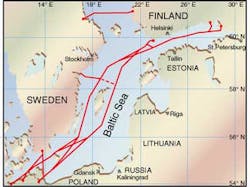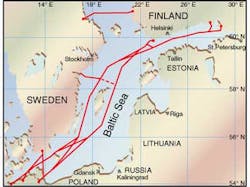OFFSHORE EUROPE: Gas trunkline network evolving across the Baltic Sea
Eastern Europe's urge to lessen its dependence on Russian gas could lead to a new network of trunklines in the Baltic Sea bearing supplies from Scandinavia. However, Russia's Gazprom may also end up increasing its exports, via another proposed line transiting the sea from Viborg to Rostock.
Poland is the main driver for the west-east schemes, as most of its gas is imported from Russia. In July, the state gas company Poland Oil and Gas Co. (POGC) signed an agreement with Dansk Olie og Naturgas (DONG) for 16 bcm of natural gas over an eight-year period. This will flow through a new 230 km pipeline to be installed between Stevns, south of Copenhagen, and Niechorz, close to Gdansk. The line, known as BalticPipe, should be operational by October 1, 2003. The estimated cost for the installation is DKr 2.5 billion.
At present, DONG and POGC are the only members of the BalticPipe consortium, with DONG holding a two-thirds interest. However, Statoil has an option to join by March 2002, and membership is open to other parties. The interest is most likely to come from Norway, which started delivering 500 MMcm/year to Poland last year via the overland pipeline network from Emden on the German coast.
Denmark, Norway
The Danish gas would be provided through increased production from fields in the Danish North Sea operated by the Dansk Undergrunds Consortium (Maersk, Shell and Texaco). In fact, the idea for the line came from a recent 30% upgrade of the DUC's gas reserves. According to DONG's President Holger Lavesen, the agreement marks "a first step on the road to the development of a gas market in the Baltic region, and [is] going to strengthen the entire energy sector in the region through an improved security of supply and an increased competition in the market."
Timing of the entry date for Norwegian gas through the line is unclear. But some outlet will be required for the 5 bcm/yr due to be shipped from Norway to Poland from around 2011, under another agreement recently inked by the two countries' premiers. According to Norwegian newspaper Aftenposten, Statoil would supply the gas for 16 years, starting in 2008, under an $11 billion contract. This could involve construction of another new subsea line between the two countries costing $1.1 billion, with possible spur sections en route taking supplies to southern Norway and southern Sweden. Again, POGC would be the main customer.
Scandinavian field analysts ScanBoss also reports that a Baltic Gas Interconnector is being proposed that would take gas from Danish fields to Sweden and Germany. The partners here are Denmark's Energi2, Norsk Hydro, Sweden's Sydkraft and Germany's Verbundnetz Gas. Following completion of a 'pre-study' in March, detailed studies are now to be undertaken which will assess individual market requirements, as well as determining potential routes and landfall sites for the pipeline. The line would have capacity of 3 bcm/yr, but this could be raised through adding compression. The potential cost is $310 million, with an earliest startup date of 2004.
Russian options
As part of the feasibility studies for the BalticPipe, DONG leased two survey vessels in summer 2000 from Geoconsult to analyze the proposed seabed route. The Geocat did duty over the shallow water stretches, while the Geograph handled the deeper water sections of the Baltic. The vessels undertook seismic surveys and also recovered large amounts of soil samples.
Two years earlier, Zeetech Engineering in Zotermeer, The Netherlands performed analyses for another proposed pipeline line carrying gas from Russia's Yamal Field across the Baltic to Germany. The work was commissioned by Gazprom and Finland's Fortum under the North Transgas consortium. Three main routes were evaluated:
- An onshore/offshore pipeline, traversing western Finland, the Gulf of Bothnia, mainland Sweden and the western Baltic, terminating in Germany
- Crossing southern Finland, then following a wholly offshore route through the Baltic to Germany
- An offshore route from Russia to Germany via the Gulf of Finland and the Baltic.
Various route options and landfall locations were considered, and the latter two studies included potential branch lines to Finland and Sweden. Additional routes east and west of the island of Gotland were also examined. Zeetech undertook preliminary pipeline system design, technical evaluation of the installation methods, and helped supervise geophysical and geotechnical surveys of the 3,000-km-long offshore routes.
Free spans, freezing
A large diameter pipeline in this area would be subject to a substantial amount of pipeline free spans, with expensive rectification work as a result. A problem could arise during the winter, when a large swath of the Baltic is liable to freeze in. At points where the pipeline would traverse adjoining shores, special measures would be needed to protect the line from ice buildup.
Since the study was completed, progress on the project has stalled, although there are reports that next-phase studies could be initiated shortly. The giant Shtokmanovskoye gas field in the Barents Sea could also come into play.
A more direct subsea route is now thought to be favored, starting near Viborg in Russia and terminating in Rostock, Germany. However, North Transgas would be a very expensive and risky investment, in terms of the pipeline length across the Baltic(1,200 km) and the need for the Russian parties to secure long-term sales.
The European Union has also devised a strategy designed to increase security of gas supplies. This has meant diversifying away from Russia, which currently supplies 40% of Europe's gas, in favor of newer sources from regions of lesser political risk such as Norway, the Caspian, North Africa, and Nigeria.
North Transgas could end up raising the percentage of gas supplied from Russia, thereby endangering supply security from the EU's point of view. On the other hand, the increasing diversity of supply sources could make Russia's share more tolerable.

